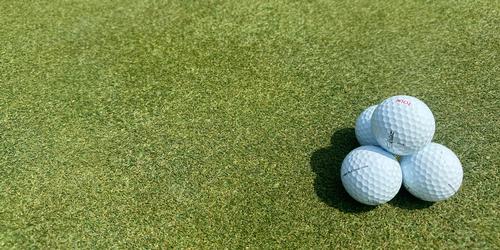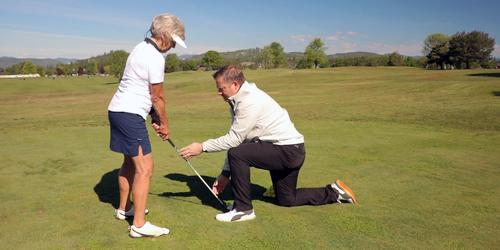WHAT IT TAKES TO SCORE WELL
By Mark Krause
Have you ever walked off the course and said, "if I would have just done this instead of that, I would have had a good score"? Scoring well does not mean that you struck the ball really well, it means that you analyzed each shot before hitting it and played the best odds. Lets take some situations. Bob and you are on the green with Bob's ball being five feet behind yours. You both look over the putt, you have figured out how much you think both of your putts will break. You then watch Bob hit his putt, but your focus is on the line the ball traveled not on the momentum he used to hit the putt and not on watching his stroke to see if he left the blade open or not, your focus was only on the line. In this case speed is the primary factor involved in the putt going in the hole, and you were just looking at his line. How much the putt breaks is determined by two factors, squareness of contact and speed of the ball. To make more putts, watch the golfers motion, then look at the line the ball is traveling on.
When chipping, you need to figure out the height you need the ball to fly based on the situation. Then select the club to hit it that height at the distance you selected. Lastly, figure out the momentum you need to hit it that distance. Always try and chip the ball past the hole, so you can then have a good idea of how much break your putt will have.
Play the odds, this is not as much fun as going for the gusto but your scores will be much better and in the end you will be proud of yourself. Playing the odds comes into play on every shot you hit. For example, it is your first hole of a member event and you normally slice the ball with the driver that you have in your hand. So, you aim at the trees on the left playing your slice and for some unknown reason the ball goes left. Why not take out the 3 wood on the first hole? You know it goes straighter so you can then aim down the left side of the fairway. By using the 3 wood you have increased your odds of hitting a solid airborne shot that normally goes straighter. You are not a scratch golfer, so why play for a par when you would be happy with a bogey. You get a stroke on the hole anyway. How about using that 3 wood on the 17th tee when you have a good score going?
Lastly, ask yourself how many times a round you have to hit a shot that is less than a full swing and many times close to the ground to get under some branches. I would guess that this short swing (including chip shots) is needed at least 18 times per round. Now ask yourself, do I know how high I hit each one of these clubs in the first 25 yards of flight? Probably not, and consequently, many of your punch shots either hit branches or run through the fairway or green. Take a bucket of balls and go under some trees next to the range, always hit at the same target using different clubs. Learn to control your height and distance by using different clubs, remembering that the further you hit the ball, the higher it will go.
Good Luck!!
Revised: 11/15/2007 - Article Viewed 31,097 Times
About: Mark Krause
![]() Owner of Muskego Lakes Country Club and PGA Professional for 33 years. Mark is the founding father of the Wisconsin State Golf Course Owners Association.
Owner of Muskego Lakes Country Club and PGA Professional for 33 years. Mark is the founding father of the Wisconsin State Golf Course Owners Association.
AWARDS
TEACHING PHILOSOPHY
To always explain "why" instead of just telling the student what to do. Use other sports that the student is more familiar with to help explain the motion of the golf swing. Strong emphasis on the body posture and ball position. Simplified explanation of the swing motion by not getting caught up in specific positions of the arms or body. Main basics that must be learned are the correct posture, keeping the right knee in the same flexed position that it had in the setup, firm left wrist position in relation to the left forearm and a turning of the shoulders to move the club in both directions.
Contact Mark Krause:
Muskego Lakes Country Club - Head Professional
414-425-6500












